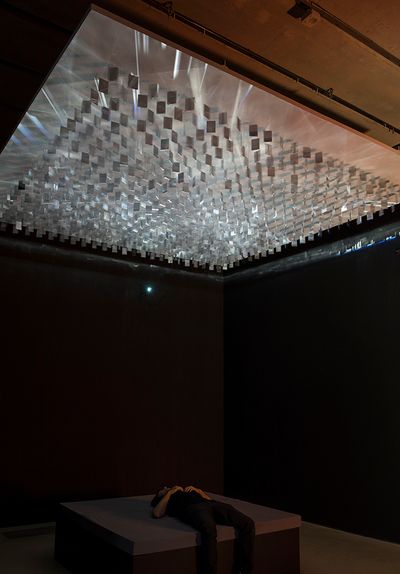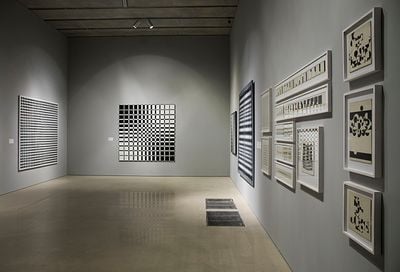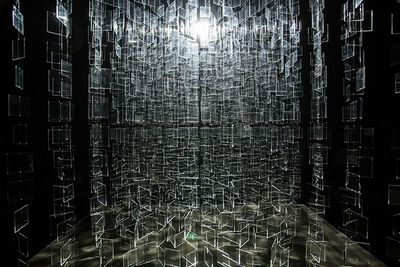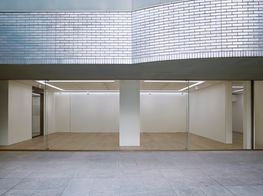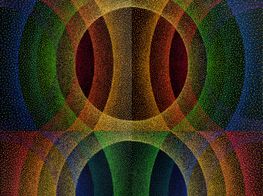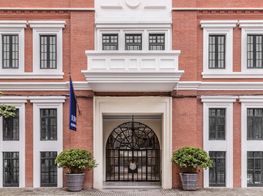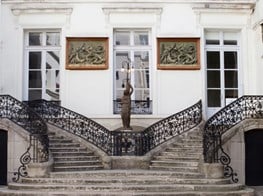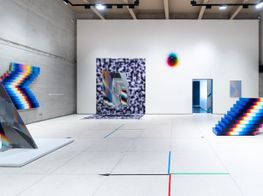Julio Le Parc: nostalgia for optimism

Julio Le Parc, Sphère rouge (Red Sphere) (200112). Plexiglas and nylon. 122 11/16 inches (diameter). Courtesy Pérez Art Museum Miami. Photo: Oriol Tarridas.
Julio Le Parc: Form into Action, the first stateside museum retrospective of Argentine artist Le Parc's oeuvre, opened 18 November 2016 against an increasingly reactionary political backdrop. The show's run, through 19 March 2017 at the Pérez Art Museum Miami (PAMM), has thus far corresponded with the rise to power of a conservative agenda, more pernicious and anti-democratic than that of any American presidency of the past half-century. Yet the circumstances may not be altogether unfamiliar to Le Parc, who entered art school in 1940s Buenos Aires during the anti-intellectual, populist dictatorship of Juan Perón. His ensuing life's work—summarised and celebrated with the more than 100 graphic paintings, sculptures, and immersive kinetic installations currently on view in Miami—has been an effort to democratise the art-viewing experience through the creation of participatory objects and environments that bespeak an abiding commitment to participatory politics. That is to say, there could hardly be a more urgent, opportune moment to recognise and evaluate Le Parc's methods, aesthetics and optimism.
'Politics have always been central to Le Parc's artistic production', asserts exhibition curator Estrellita B. Brodsky in her catalogue essay. Le Parc's reaction against authoritarianism as a teenager and young adult at the Escuela de Bellas Artes drove the artist to reject also the oppressive art world norms he encountered upon moving to Paris in 1958: the singularity of painting, the vaunted notion of the genius artist, and the hegemonic control that museums exercised over presenting art and its discourse to the public at large. Le Parc developed a research-driven practice in response to such stultifying conditions, experimenting with modes of public engagement, movement, material, colour, and light over the following six decades. (Though the sprawling Miami display skews heavily toward his career from the late 1950s through the 1970s, Le Parc continues to produce new work even as he nears his ninth decade—the most recent object in the PAMM show dates to 2013.) He resisted elitism by making art that was visceral and experiential, which could thus inspire a reaction from even the most uninformed participant. Fittingly, Form into Action presents a deeply egalitarian protagonist, for whom formal experimentation was a civic duty of the highest order, not merely an end in and of itself.
Le Parc's earliest works, the two-dimensional geometric studies from the late 1950s that fill several introductory galleries at PAMM, contain the seed of a utopian sentiment that defines his creative output in the consequent halls. By painting slightly rotated geometric forms in sequential arrangements—including No. 12, Rotación traslativa (1959) and Hommage solennel (Séquences progressives ambivalentes) (1959/70)—Le Parc used stationary images to create the impression of real-time movement for the viewer. That perceived dynamism was an early effort to transform the viewer from a passive spectator into an active participant, whose subjective experience of the artwork was as valid a judgment of its merits as that of any professional curator or critic. By emphasising the mutability of individual perception, Le Parc placed the viewer, rather than the work of art, at the centre of gravity in his creative universe. He, in turn, occupied the role of scientist or mathematician, systematically researching the seemingly infinite permutations of simple forms and colours that could engage and inspire the viewer.
After making fixed two-dimensional images appear to move, Le Parc began producing active, three-dimensional installations in the early 1960s with motile parts that constantly mutate and move in space to physically engage the viewer. He has gone down in art history as a founding figure in kinetic art, famous in particular for the mobiles and immersive, architectural-scale environments that occupy prime real estate in the Miami retrospective. Yet the show also makes clear that Le Parc never abandoned painting, and indeed one of the retrospective's highlights is the 10-canvas work La Longue Marche (1974). The painting's monumental scale and colour scheme convey palpable joy as readily as its title evokes the resurgent militarism that dominated international politics of the decade. A massive rainbow-hued line that winds, loops, and twists across a white background, the painting pushes the viewer beyond awe-struck contemplation to a heightened awareness of the immediate environs. When the line's colourful arc abruptly stops, its energy—a sense of ceaseless motion and infinite possibility—is deposited into the gallery.
That ebullience carries into the subsequent rooms, devoted to the kinetic sculptures, mobiles, lightboxes, and immersive cells that are Le Parc's most oft-cited and oft-Instagrammed legacy. To be sure, it feels somewhat ironic to experience these works—several of which were created in opposition to what Le Parc derided as the rarified trappings and anaesthetising effects of traditional museum settings—in an institutional context. And yet, these pieces generate alternate, disorienting environments that counter placid regularity with spontaneous, ever-changing visual stimuli, engaging the viewer's experience as one of the artwork's component parts. Le Parc's materials and methods recur throughout these objects, but the effects are distinct in each encounter. A panoply of small plastic or metallic shapes hang in perfect order and rotate individually for the mobiles, like Continuel-lumiere au plafond (1963) or Sphère rouge (2001-12). Whereas the former invites the viewer to contemplate the ceiling, even as it reflects squares onto the viewer below, and thereby acknowledges that art need not be static, or framed, or on a wall, the latter piece casts an array of red shadows onto the gallery walls and thus underscores both the spatial and ideological constraints of the museum setting. He achieves these ends with admirable subtlety, by spurring the viewer to draw conclusions from a deeply personal encounter with the work. Mirrored surfaces heighten the patently subjective experience produced by Le Parc's installations—the viewer navigates a maze of mirrors in Cellule a penetrer (1963), made to recognise that her reflection is an essential component of the piece by its sheer omnipresence in that immersive environment. This inhabitable 'cell' installation, and several others like it, establishes a dazzling environment completely removed from the usual civility of the museum.
Yet Le Parc would hardly be so widely recognised and renowned were it not for the efforts of various art world establishments to promote his oeuvre. His canonisation in the collections and exhibition programs of major cultural institutions—the Palais de Tokyo in Paris also staged a major retrospective of his work in 2013—is supported in no small part by the Brazilian gallerist Nara Roesler, who has shepherded the artist's legacy to a renewed 21st-century prominence in the public sphere and in private collections. Her eponymous gallery prominently featured Le Parc's work at Art Basel in Hong Kong in 2016 and, concurrent with the PAMM show, devoted much of her booth to his work in Miami. Indeed, more than a few of the private collections that lent to the Miami show acquired the pieces on view through her efforts. As such, Le Parc's PAMM retrospective is also a celebration of Roesler commitment and diligence.
The most celebratory section of the show is, in fact, the last: a gallery turned game room replete with playful motorised installations that are activated by the viewer, just as much toys as they are works of art. Miroir en vibration (1965), for example, undulates and issues a shrill noise at the push of a button, and likewise 3 jeux avec balles de ping-pong (1965) sends its contents spinning through a geometric course when prompted by the visitor. The consequences are of course fun, but also adamantly affirmative: the viewer has agency to touch and invigorate the art, a breach of the standard museum protocol that insists on a decidedly more passive art-viewing experience. The overall effect, not only of this section but of Form into Action in sum, is to rejoice in the individuality and freedom of the viewer. Le Parc's inherent optimism and candour are a far cry from the current state of affairs writ large, but then, those same attributes are the kernel of a potent rallying cry for another future. —[O]

